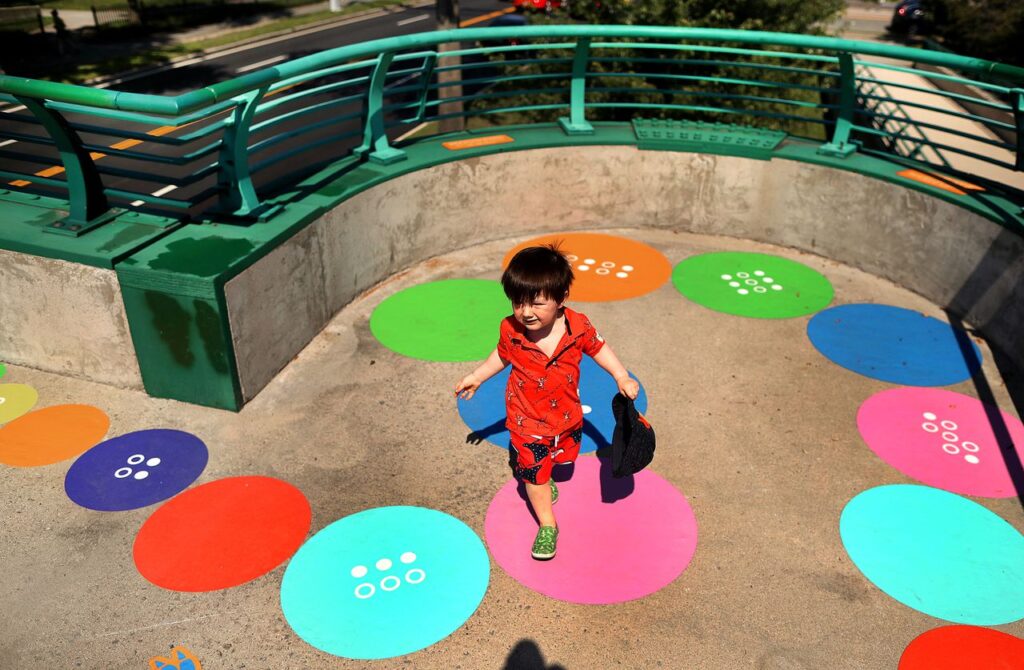By Ivy Scott
THE BOSTON GLOBE
Dozens of elementary-aged children, giggling and shouting, galloped and hopped across the Magazine Beach pedestrian bridge Saturday morning for the grand opening of the new Math Trail.
Designed by the Charles River Conservancy and tech company MathTalk, in partnership with community members and the Department of Conservation and Recreation, the installation’s goal is to improve math literacy for low-income students while increasing opportunities to learn in nature, according to Keith Griffin, the lead organizer for family and community engagement at MathTalk.
“Resources don’t always make it into these areas,” he said, “and we knew if we wanted change for our community, we’d have to put a footprint down and do it ourselves.”

And the dull concrete walkway of the pedestrian bridge was indeed brightened with footprints, along with multicolored numbers, geometric shapes, and animal tracks. Red, yellow, and blue lines measured the distance from place to place at 3-foot intervals, encouraging kids to look for patterns as they crossed the bridge.
Two-year-old Nirona Ashar jumped eagerly from line to line, passing numbers that counted higher and higher as the bridge curved into the sky. Her mother, Shana Ashar, said she was excited to have a place in the neighborhood where her daughter could come to play — and learn at the same time.
“She’s the perfect age for this, because it’s all about counting and measuring,” Ashar said.
The installation reminded her of the Harvard Bridge, once famously measured by MIT students using the fictional unit “smoots,” she said, but this one was custom made for children.
“It uses objects that little kids are familiar with, like paws or dinosaur feet,” she said.
Nirona’s grandmother, Mary Pepin, said it also offers fun for adults who can let their inner child out to play.
“It’s neat if you can think like a kid, too,” she said with a smile.
The installation is accompanied by its own app, Measure! Everything!, created by the MathTalk team to be adaptable to any environment, not just the park. Using augmented reality and the iPad‘s camera function, the app overlays images of animals and other objects onto the user’s surroundings, visible through the screen.
At the park, kids held their iPads out in front of them to measure the length of the bridge in wolves, or the height of a tree in anacondas.
Jasmine Lainez watched her three children as they zipped across the bridge and back into the park, leaping onto the tire swing with iPad in hand. Lainez said that she saw the event on Facebook the night before and that it piqued her interest enough to bring her kids across Cambridge via bus on a Saturday morning to the bridge.
Her two oldest children were into math, she said, but the youngest was a natural artist who often felt discouraged by math,telling her mother, “there are always problems I can’t solve.”
“She just needs a real-world application, because she does math all the time and doesn’t realize it,” said Lainez.
Sitting crisscross on the ground, Harmony quietly made herself a profile on the iPad and tapped “six” for her age before shyly angling the screen away as the first game started. Seconds later, however, the sight of a caterpillar prompted her to confidently rattle off a list of butterfly species.
“It could become a swallowtail, or a painted lady, or a monarch!” she said.
“Making math accessible for kids is important, so that kids who have a complex about it will see that they can do it, too,” she said.
Angeline UyHam, a designer with MathTalk and a design and innovation coach for the Cambridge school district, said the process of creating the Math Trail involved a student workshop, where students engaged in drawing, dreaming, and “a lot of dancing.”
“The kids get that math lives everywhere — in the geese, in the bridge, in the park, and in you,” UyHam said.
“What kids are craving is novelty and impact, and even thinking about outdoor spaces was meaningful and joyful at a time like this,” she said.
Come September, more activities will be offered for students along the trail, said Laura Jasinski, executive director of the Conservancy. Jasinski said she was hopeful that another installation would be developed soon at the Charles River Reservation, ideally with a bike route connecting the two.
“This is about extending the classroom across the street into the park,” she said. “Every time kids come, they’ll see something new they can engage with.”
